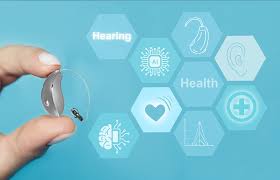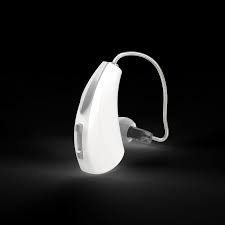A Quiet Revolution in Health Tech
For years, hearing aids were little more than tiny speakers — tools that made the world a bit louder but not necessarily clearer. They helped, sure, but they often left users frustrated, lost in a blur of sounds.
Now, that’s changing. Artificial intelligence is quietly rewriting the story of hearing loss. These new smart devices aren’t just amplifying sound; they’re understanding it. They learn, adapt, and evolve — helping people reconnect with the world in ways that once felt impossible.
It’s more than a tech upgrade. It’s a glimpse into a future where healthcare doesn’t just treat us — it understands us.

From Amplifiers to Intelligent Companions
Old hearing aids were simple: they made everything louder. The problem? They couldn’t tell the difference between your friend’s laugh and the roar of a passing truck.
But today’s AI-powered models are like having a personal sound engineer in your ear. They use advanced algorithms to separate voices from background noise, adjusting to your surroundings in milliseconds. Imagine sitting in a noisy café — and still hearing your best friend’s voice clearly, as if the rest of the world faded into the background.
Companies like Oticon, Starkey, and Widex are at the forefront, building devices that analyze the environment up to a thousand times per second. Every moment, they’re learning how you listen.
“Artificial intelligence has transformed hearing aids from amplifiers into intelligent companions,” explains Dr. Lauren Reeves, an audiologist at Stanford’s Health Tech Lab. “They’re starting to focus and adapt the way the human brain does.”
The Science of Listening Like a Human
At the heart of this transformation lies machine learning — algorithms that evolve as they collect data. These AI hearing aids are constantly learning from thousands of real-world listening experiences. Over time, they recognize your preferences: the voices that matter most, the sounds that comfort or annoy you, even how you like the world to feel when you hear it.
A major breakthrough is neural sound mapping. This technology mimics how our brains focus on specific sounds — like a loved one’s voice in a crowd.
Picture yourself at a family dinner. Laughter, clinking dishes, music in the background — chaos, right? Yet, your hearing aid zeroes in on your daughter’s voice across the table. It’s not just smart. It’s human.
“This is the magic of AI meeting neuroscience,” says Dr. Reeves. “For the first time, technology is learning to listen like we do.”
Beyond Hearing: A Health Companion in Disguise
These aren’t just hearing aids anymore. They’re turning into full-fledged health companions.
The newest AI models can track how your brain processes sound — a potential early warning sign of cognitive decline. They can detect changes in balance and movement, helping prevent falls in older adults. Some even include real-time language translation or subtle health monitoring features.
It’s like having a tiny guardian in your ear — one that listens, learns, and quietly looks out for you.
A Lifeline for an Aging World
Over 430 million people worldwide live with disabling hearing loss. For many, it’s not just about sound — it’s about connection. Losing the ability to hear often means losing the ability to participate, to laugh, to belong.
That’s what makes this AI revolution so powerful. It’s giving people their lives back.
Studies show that those using advanced hearing tech experience less loneliness, better mental health, and sharper cognition. Some models even track social activity — a subtle way to help doctors monitor emotional wellbeing.
“Loneliness is as damaging as smoking fifteen cigarettes a day,” says Dr. Miguel Torres, a geriatric specialist in Madrid. “When AI helps people stay connected — that’s not just good medicine, that’s humanity in action.”
The Data Dilemma: When Privacy Meets Progress
But there’s a catch. AI-powered hearing aids don’t just hear for you — they also listen. Constantly. They process sound, voice, and location data. In the wrong hands, that could reveal who you talk to, where you go, even how you feel.
“Your hearing aid might be one of the most intimate sensors you own,” warns privacy expert Ava Klein. “We need to make sure that data is protected as fiercely as your medical records.”
To tackle this, many manufacturers are moving toward on-device AI, processing everything locally instead of in the cloud. It’s a technical challenge, but it keeps your conversations exactly where they belong — private.

The Price of Progress
Here’s the uncomfortable truth: innovation isn’t cheap. Right now, top-tier AI hearing aids can cost anywhere from $2,000 to $6,000 per ear — a serious barrier for many.
Thankfully, the landscape is shifting. The U.S. FDA recently approved over-the-counter hearing aids, and more affordable AI versions are already emerging. As AI chips become smaller and cheaper, we’ll likely see this life-changing tech reach more people.
“The history of technology tells us one thing,” says market analyst David Lang. “What’s elite today will be standard tomorrow. Hearing tech is on that path.”
When Technology Restores Humanity
Beyond all the science, there’s something deeply emotional happening here. People are hearing again — not just sounds, but life itself.
Take Margaret Liu, 72, who told The Health Journal:
“I heard rain for the first time in years. It wasn’t just sound — it was memory. It was peace.”
That’s what this technology represents. Not machines replacing humans, but machines helping us feel more human.
What It Means for the Future of Health Tech
AI hearing aids aren’t just transforming audiology — they’re rewriting the blueprint for healthcare itself. Devices that learn from the user, predict problems, and respond in real time could soon be everywhere: in heart monitors, smart glasses, even brain interfaces.
“The ear is just the beginning,” says Dr. Reeves. “Once we understand how to merge AI with human senses, every part of medicine could become more personal, more intuitive, more alive.”
These hearing aids are more than gadgets. They’re proof that technology can listen — and care.

Final Thoughts
AI-powered hearing aids are reshaping what it means to hear, to age, to connect. They combine empathy and innovation, data and emotion — showing that the most powerful technologies are often the quietest ones.
For millions living in silence, this isn’t just a tech story. It’s a story about belonging. About the simple joy of hearing your loved one say your name again.
And maybe, just maybe, it’s a reminder that in a noisy world, the smartest technology is the one that helps us listen.
If you want more on AI tech innovations, see